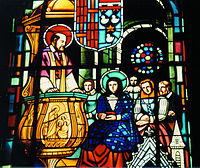"What matters in life is not great deeds, but great love." -St. Therese, The Little Flower
For almost 4 years of stay in The Sisters of Mary the most important teaching the nuns inculcated in me is the importance of small deeds offered to God.
I remember how we used to offer:
the washing of 50pairs of socks every afternoon...
the pain of kneeling down for an hour or so during station of the cross...
the difficulty in staying awake during rosary prayer at night...
the happiness when we got the perfect score in the test...
the hardship in keeping the mouth shut from 7:30 pm till 7:00 am (silent time)...(being talkative in nature, it's really a big sacrifice)
the hardship in keeping the mouth shut from 7:30 pm till 7:00 am (silent time)...(being talkative in nature, it's really a big sacrifice)
the endurance in jogging 3 rounds in the oval or around the campus...
the little act of kindness extended to our fellow student....
the practice of virtues of obedience, charity, faith, sacrifice etc...
Every memory is still fresh on my mind and the happiness we felt because of those small offerings for the glory of God is really unfathomable. I've realized in those offering, the simple act became greater because everything was done out of love.
How the sisters came up with such great motivating factor? It's because of St. Therese, The Little Flower. The nuns who are selflessly taking care of the children inside The Sisters of Mary institution follow the life of St. Therese and thus, the children are encouraged to do likewise.
Learning about St. Therese is a blessing. May you be blessed upon reading her story.
Feast Day: October 1



Therese Martin was the last of nine children born to Louis and Zelie Martin on January 2, 1873, in Alencon, France. However, only five of these children lived to reach adulthood. Precocious and sensitive, Therese needed much attention. Her mother died when she was 4 years old. As a result, her father and sisters babied young Therese. She had a spirit that wanted everything.
At the age of 14, on Christmas Eve in 1886, Therese had a conversion that transformed her life. From then on, her powerful energy and sensitive spirit were turned toward love, instead of keeping herself happy. At 15, she entered the Carmelite convent in Lisieux to give her whole life to God. She took the religious name Sister Therese of the Child Jesus and the Holy Face. Living a hidden, simple life of prayer, she was gifted with great intimacy with God. Through sickness and dark nights of doubt and fear, she remained faithful to God, rooted in His merciful love. After a long struggle with tuberculosis, she died on September 30, 1897, at the age of 24. Her last words were the story of her life: "My God, I love You!"

The world came to know Therese through her autobiography, "Story of a Soul". She described her life as a "little way of spiritual childhood." She lived each day with an unshakable confidence in God's love. "What matters in life," she wrote, "is not great deeds, but great love." Therese lived and taught a spirituality of attending to everyone and everything well and with love. She believed that just as a child becomes enamored with what is before her, we should also have a childlike focus and totally attentive love. Therese's spirituality is of doing the ordinary, with extraordinary love.
Therese saw the seasons as reflecting the seasons of God's love affair with us.She loved flowers and saw herself as the "little flower of Jesus," who gave glory to God by just being her beautiful little self among all the other flowers in God's garden. Because of this beautiful analogy, the title "little flower" remained with St. Therese.
Her inspiration and powerful presence from heaven touched many people very quickly. She was canonized by Pope Pius XI on May 17, 1925. Had she lived, she would have been only 52 years old when she was declared a Saint.
"My mission - to make God loved - will begin after my death," she said. "I will spend my heaven doing good on earth. I will let fall a shower of roses." Roses have been described and experienced as Saint Therese's signature. Countless millions have been touched by her intercession and imitate her "little way." She has been acclaimed "the greatest saint of modern times." In 1997, Pope John Paul II declared St. Therese a Doctor of the Church - the only Doctor of his pontificate - in tribute to the powerful way her spirituality has influenced people all over the world.
The message of St. Therese is beautiful, inspiring, and simple.
Here are some records of miraculous intercession of St. Therese to those who believe in her...
Intercessions of St. Therese
Here are some records of miraculous intercession of St. Therese to those who believe in her...
Intercessions of St. Therese


.jpg)



